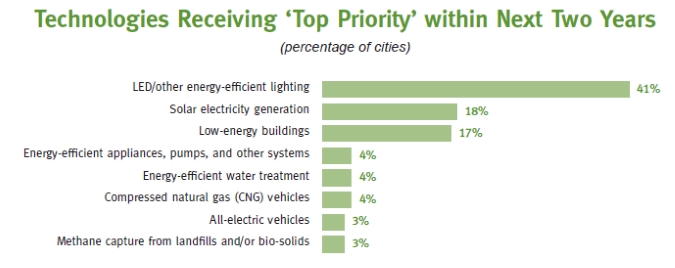Arianna Tozzi from The Climate Group addresses in this article how U.S. mayors are valuing LED lighting replacements in their efforts to reduce city carbon emission and energy consumption.
U.S. mayors rank energy efficient LED lighting as the most promising technology for city managers to reduce their energy use and carbon emissions over the coming two years, according to a survey held at the United States Conference of Mayors (USCM) in Washington DC earlier this year.
In the survey, entitled ‘How energy Technologies are Reshaping America’s cities’, LED lighting surpassed 17 other clean technologies and low carbon solutions as the technology of choice for mayors.
Gathering in Washington for their annual meeting, the USCM is an official non-partisan organization of representatives from 1,400 US cities larger than 30,000 inhabitants, which brings mayors together to promote the development of national and urban policy.
Results from the survey build on a similar investigation in 2014 where LEDs were given priority over other low carbon technologies in US cities, with a 29% consensus. Two years after this first survey, agreement around the benefits of LED lighting has grown dramatically, as the technology is now leading all others with a 41% share of registered polls.
Also scoring highly to make up the top three priorities for mayors were low energy buildings (17%) and solar electricity (18%).
ENERGY EFFICIENT STREET LIGHTING
Many of the US cities polled are already benefitting from energy efficient LED lighting, with more than four in five having deployed it in some form such as public buildings or street lighting. Nearly half of interviewed mayors are also planning on deploying LEDs more broadly in the coming two years. Street lighting in particular is the application of choice, with 81% of surveyed cities planning LED street lighting upgrades over the next 24 months.
A key reason LED lighting scored so highly is the potential it offers to reduce electricity bills by up to 50-70%, increase energy savings and lower maintenance costs. Socio-economic benefits linked to better-lit city environments is another driver for adoption, with enhanced lighting linked to increased public safety and well-being.
When it comes to ‘connected lighting’, a terms that refers to lighting that is monitored and managed remotely using embedded software, 67% of poll respondents are familiar with the terminology and as many as 6 in 10 of those are now actively considering its deployment. Connected lighting is linked to an additional 5-25% energy savings for streetlights.
When asked about remaining barriers to adoption, city majors pointed to a lack of internal resources (56%) and complex ownership of the light poles (39%) as the two main obstacles.
ACCELERATING ADOPTION
Over the past two years, The Climate Group, in partnership with Philips lighting, has been running a global consultation program to identify and address remaining barriers to wide-scale energy efficient lighting adoption.
Street lighting ownership was highlighted as a particular obstacle in US cities. Currently there are an estimated 26 million streetlights in the US, of which up to 60% are part or wholly owned or operated by the private sector.
To address this issue and other barriers to adoption, in December 2014, we held a consultation workshop at theNational League of Cities Congress in Austin, Texas. Peter Curley, Program Manager for the LED Scale-up program at The Climate Group said: “The workshop highlighted how city managers now clearly see the monetary and environmental benefits from a transition to energy efficient lighting and want to scale up LEDs.
“Technological barriers have now been overcome but adoption is still being delayed. Particularly in the US, many cities reported that complex ownership of the public lighting is delaying adoption, and asked for assistance in highlighting this barrier and to convene stakeholders to explore mutually beneficial solutions.”
Acknowledging the urgent need for such a dialogue, at Climate Week NYC in September 2015 we held a roundtable with key US stakeholders and city representatives to discuss innovative polices that could encourage the transition, such as incentivizing investor-owned US utilities. During the event, The Climate Group called on US utilities to publish their intention to explore the benefits of LED lighting by the end of 2016.
Through 2016 and beyond, The Climate Group will continue to drive the conversation around accelerating LED adoption by convening roundtables with stakeholders, exploring new policy solutions and highlighting best practice and progressive utilities.
· Find out more on The Climate Group's LED Scale-up program





 CN
TW
EN
CN
TW
EN






